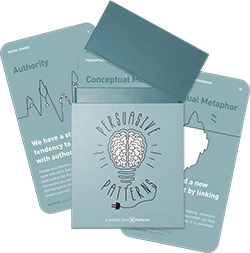Present Bias
Design Pattern
Problem summary
What we want now is not what we aspire to in the future
Usage
- Use to boost sales by exploiting our bias toward instant gratification over future rewards
- Use to separate users present-self from their future-self to help them in making healthier long-term choices.
This card is part of the Persuasive Patterns printed card deck
The Persuasive Patterns Card Deck is a collection of 60 design patterns driven by psychology, presented in a manner easily referenced and used as a brainstorming tool.
Get your deck!Solution
- Facilitate future lock-in. Help users make healthier long-term choices and secure the best long-term consequences of their decisions by segregating making a decision from receiving the consequences. Encourage customers to order groceries several days in advance to separate their present self from their future self and in turn reduce impulse purchases.
- Optimize sales for the near-future. It is more likely that customers will spend more money in the near future than in the more distant future.
- Boost impulse sales. Using the Present Bias to boost sales, you could adapt product recommendations to include impulse purchases through time-restricted special offers.
Rationale
Our short-term desires (wants) and longer intentions (should) differ wildly. We tend to focus on and over-value immediate rewards at the expense of long-term wishes and benefits. Allow customers to perform “future lock-in” to help them make healthier “should” choices rather than caving in to here-and-now “wants”.
People are biased towards the present as the perceived value of receiving a reward in the immediate future falls rapidly and only less more looking to the distant future. This model of how the value of a reward is discounted over time is called Hyperbolic discounting and is a form of Delay Discounting, which are cornerstones of behavioral economics.
1 Milkman, Rogers & Bazerman (2010). Ice cream soon and vegetables later: A study of online grocery purchases and order lead time. Marketing Letters 21(1):17-35
2 Balakrishnan, Haushofer & Jakiela (2017). How Soon Is Now? Evidence of Present Bias from Convex Time Budget Experiments. Cambridge, MA.
3 Present Bias at Wikipedia.org
4 Dynamic inconsistency at Wikipedia.rg
5 Present Bias at Coglode.com
6 What Goes Around Comes Around: Behavioral “Lock In,” and How to Crack It to Save the Planet by Toby Park
7 The Present Bias at Learning Loop
User Interface Design Patterns
- Forms
- Explaining the process
- Community driven
- Tabs
- Jumping in hierarchy
- Menus
- Content
- Gestures
- Tables
- Formatting data
- Images
- Search
- Reputation
- Social interactions
- Shopping
- Increasing frequency
- Guidance
- Registration
Persuasive Design Patterns
- Loss Aversion
- Other cognitive biases
- Scarcity
- Gameplay design
- Fundamentals of rewards
- Gameplay rewards


